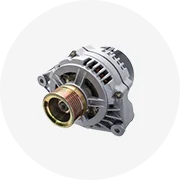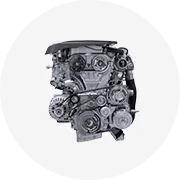What Is a Monkey Bike Fork?
A monkey bike fork is a critical component of a monkey bike - a small, lightweight motorcycle with a seat height of about 68–70 cm. Originally developed by Honda in the 1960s, these compact motorcycles (also known as Z bikes or mini bikes) feature specialized forks designed for their unique dimensions and riding characteristics.
Key fact: The term "monkey bike" comes from the riding position, which resembles a monkey on a bicycle with knees high and arms extended.
Types of Monkey Bike Forks
The most common type used on monkey bikes, featuring two fork tubes that slide up and down. Each tube contains:
- Internal spring
- Damping mechanism
Best for: Everyday road riding and light off-road use
Advantages: Good stability, straightforward maintenance, affordable replacement parts
Also known as inverted forks, these position the damping components and springs on the sliding tubes for:
- Improved stability during braking
- Better cornering performance
- More precise steering feel
Best for: Sports-oriented monkey bikes and performance riding
Advantages: Superior handling, reduced unsprung weight, more precise steering
Unique design where one side of the fork holds the wheel axle while the other connects to the chassis:
- Simplified bike structure
- Allows quick wheel removal without brake disassembly
Best for: Racing applications and high-end monkey bikes
Advantages: Quick wheel changes, distinctive appearance, reduced weight
A traditional design using springs to connect fork blades that:
- Move laterally when encountering bumps
- Provide a distinctive retro look
- Offer unique suspension characteristics
Best for: Classic or retro-style monkey bikes
Advantages: Distinctive vintage appearance, smooth ride quality
Custom forks that combine elements from different fork types to:
- Meet specific performance needs
- Accommodate particular bike models
- Suit specialized riding styles
Best for: Custom builds and specialized applications
Advantages: Tailored performance characteristics, unique appearance
| Fork Type | Best Application | Maintenance Level | Cost Range | Weight |
|---|---|---|---|---|
| Standard (Telescopic) | General purpose, street riding | Low to medium | $80-$150 | Medium |
| Upside-Down (USD) | Sport riding, performance use | Medium to high | $150-$300 | Medium-light |
| Single-Sided (SSSA) | Racing, specialized applications | Medium | $200-$400 | Light |
| Springer | Classic/retro style bikes | Low | $100-$200 | Heavy |
| Hybrid | Custom applications | Varies | $150-$500 | Varies |
Specifications of Monkey Bike Forks
Dimensions and Materials
| Specification | Details | Why It Matters |
|---|---|---|
| Fork Length | 230mm - 250mm | Affects stability and handling |
| Fork Material | Steel or aluminum | Impacts weight, strength, and cost |
| Axle Size | 12mm - 15mm diameter | Determines wheel compatibility |
| Fork Weight | 1kg - 1.5kg | Affects overall bike weight and handling |
| Steerer Tube Diameter | 25mm - 30mm | Must match frame headset size |
| Suspension Travel | 50mm - 70mm | Determines bump absorption capability |
Technical Features
| Feature | Common Options | Performance Impact |
|---|---|---|
| Brake Type Compatibility | Disc or drum | Affects stopping power and maintenance |
| Fender Mounts | Present or absent | Enables weather protection options |
| Fork Design | 2 legs (standard) | Affects weight distribution and stability |
| Damping Adjustment | Fixed or adjustable | Allows customization of ride quality |
| Spring Rate | Soft, medium, or stiff | Determines comfort vs. responsiveness |
| Dropout Style | Standard or quick-release | Affects ease of wheel removal |
Pro tip: Steel forks are generally more durable and offer better vibration dampening, making them ideal for off-road use. Aluminum forks are lighter and corrosion-resistant, making them better for road use or in areas with high humidity or salt exposure.
Maintenance of Monkey Bike Forks
Regular maintenance is crucial! A well-maintained fork not only performs better but also lasts significantly longer. Even basic maintenance can prevent costly repairs or replacements.
Essential Maintenance Tasks
- Regular Inspection: Check for cracks, dents, or bends that could compromise structural integrity. Immediately stop using the bike if damage is found.
- Cleaning: Use mild soap and water with a soft cloth or brush to prevent dirt buildup. Avoid high-pressure water that could penetrate seals.
- Lubrication: Apply appropriate lubricant to moving parts, particularly where fork tubes enter the lower legs. This prevents rust and ensures smooth operation.
- Brake Maintenance: Regularly inspect brake components attached to the fork. Replace worn pads and clean disc or drum brake surfaces for optimal stopping power.
- Wheel Alignment: Ensure equal gaps between wheel and fork legs on both sides. Adjust wheel spacers if necessary to maintain proper alignment.
- Fork Replacement: Consider replacing severely damaged or worn forks rather than attempting repairs that might compromise safety.
Maintenance Schedule
| Maintenance Task | Frequency | Tools Required |
|---|---|---|
| Visual inspection | Before each ride | None |
| Clean fork exterior | Weekly or after muddy rides | Soft brush, mild soap |
| Check bolt tightness | Monthly | Allen keys, spanners |
| Lubricate seals | Every 3 months | Fork oil or seal lubricant |
| Check axle alignment | Every 6 months | Ruler or alignment tool |
| Full fork service | Yearly | Fork service kit, specialized tools |
Warning: Never attempt to disassemble pressurized fork components without proper knowledge and tools. The sudden release of pressure can cause serious injury. If you're unsure, consult a professional mechanic.
How to Choose the Right Monkey Bike Fork
Different riding styles demand specific fork characteristics:
- Street riding: Standard telescopic forks with moderate travel
- Off-road adventures: USD forks with longer travel
- Mixed terrain: Hybrid forks with adjustable settings
- Classic/vintage look: Springer forks for aesthetic appeal
Choose the right material based on your priorities:
- Steel: Durable, absorbs vibration, heavier, more affordable
- Aluminum: Lightweight, rust-resistant, more responsive, higher cost
- Carbon fiber: Ultra-lightweight, expensive, found on premium models
Ensure your new fork is compatible with your bike:
- Wheel size: Must match your wheel dimensions
- Brake system: Compatible with disc or drum brakes
- Steerer tube: Must match headset dimensions
- Axle width: Must accommodate your wheel hub
Price ranges for different quality levels:
- Entry-level: $80-$150 (basic functionality)
- Mid-range: $150-$300 (improved performance)
- Premium: $300+ (advanced features, lightweight materials)
Remember: A quality fork is an investment in safety and performance
| Selection Factor | Priority Level | Key Considerations |
|---|---|---|
| Riding Style | High | Match fork type to primary riding terrain and usage |
| Weight Capacity | Critical | Must support rider weight plus any cargo |
| Stiffness/Stability | High | Adequate for intended speed and terrain |
| Compatibility | Critical | Must match frame, wheel, and brake specifications |
| Budget | Medium | Balance cost with quality and features needed |
| Brand Reputation | Medium | Research reliability history and warranty support |
Expert advice: When possible, test ride a monkey bike with the same fork model you're considering. The real-world feel can differ significantly from specifications on paper, especially regarding suspension response and handling characteristics.
DIY: How to Replace a Monkey Bike Fork
Safety first! If you're not confident in your mechanical abilities, we strongly recommend having a professional mechanic perform this installation. Improper fork installation can lead to catastrophic failure while riding.
Tools Required:
- New fork (compatible with your bike model)
- Monkey bike tire pressure gauge
- Monkey bike torque wrench
- Complete monkey bike tool kit
- Ratchet and socket set
- Allen key set
- 10mm spanner
- 15mm spanner
- Grease or anti-seize compound
- Clean rags and degreaser
Step-by-Step Installation Guide:
- Prepare your work area: Place the monkey bike on a stable workbench or stand. Ensure it's secure and won't tip over during the procedure.
- Remove the front wheel: Use an Allen key or 5mm socket to loosen and remove the front wheel axle. Carefully slide the wheel out of the fork dropouts.
- Detach the brake caliper: Use a 10mm spanner to remove the brake caliper mounting bolts. Carefully set the caliper aside without disconnecting the brake line.
- Remove the mudguard: Use an 8mm spanner to remove the mudguard mounting bolts and set the mudguard aside.
- Loosen the yoke pinch bolts: Use a 12mm spanner for the top yoke pinch bolts and an 8mm Allen key for the bottom yoke pinch bolts.
- Disconnect the handlebars: Use a 14mm spanner to remove the stem nut, allowing you to separate the handlebars from the bike.
- Remove the fork leg bolts: Use a 10mm spanner to remove the bolts connecting the fork legs to the bike frame.
- Extract the old fork: Carefully slide the old fork downward and out of the head tube.
- Prepare the new fork: Apply grease to bearing surfaces and ensure all components are properly aligned.
- Install the new fork: Carefully insert the new fork into the head tube, following the specific manufacturer's instructions for your model.
- Reassemble in reverse order: Reinstall all components (handlebars, brake caliper, mudguard, and front wheel) in the reverse order of removal.
- Final checks: Verify all bolts are properly torqued to specification, brakes function correctly, and steering moves freely without binding.
Professional tip: Take photos during disassembly to document the exact position and orientation of all components. This visual reference will be invaluable during reassembly, especially for complex parts like brake calipers or mudguard mounting brackets.
Frequently Asked Questions
A monkey bike fork is the front suspension component of a monkey bike (a small, compact motorcycle with a seat height of 68-70cm). It connects the front wheel to the frame while providing steering capability and suspension for absorbing bumps. The fork is crucial for handling, stability, and control of the motorcycle.
Monkey bikes can be equipped with several fork types, each with distinct characteristics:
- Telescopic forks: The most common type with tubes that slide up and down
- Upside-Down (USD) forks: Inverted telescopic forks for improved performance
- Single-sided forks: Hold the wheel on one side only for quick changes
- Springer forks: Traditional design with visible springs for classic look
- Leading link forks: Use pivoting arms for suspension movement
- Hybrid designs: Combine features from multiple fork types
Monkey bike forks are typically constructed from:
- Steel: Strong and durable but heavier. Offers excellent vibration damping and is more affordable.
- Aluminum: Lightweight and corrosion-resistant. More expensive than steel but reduces overall bike weight.
- Carbon fiber: Found in high-end models only. Extremely lightweight but very expensive and less common.
The choice of material affects weight, durability, performance, and cost of the fork.
Yes, monkey bike forks can be extensively customized and upgraded. Common modifications include:
- Upgrading to a different fork type for improved performance
- Adding adjustable damping for better suspension control
- Installing progressive springs for improved ride quality
- Changing to anodized or chrome finishes for aesthetic enhancement
- Converting to disc brake compatibility for better stopping power
- Extending fork length for increased ground clearance
When customizing, always ensure modifications maintain structural integrity and don't compromise safety.
A proper maintenance routine for monkey bike forks includes:
- Regular cleaning: After each ride, especially in muddy conditions
- Inspection: Check for signs of damage, leaking oil, or unusual wear
- Lubrication: Apply appropriate lubricant to moving parts quarterly
- Seal maintenance: Replace worn seals to prevent dirt ingress and oil leakage
- Oil changes: Replace fork oil according to manufacturer recommendations
- Hardware checks: Periodically verify all bolts and fasteners are properly torqued
Following these maintenance practices will extend the life of your fork and ensure optimal performance.

























































